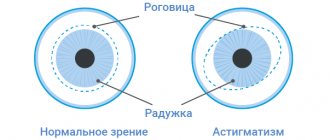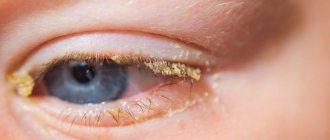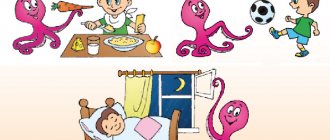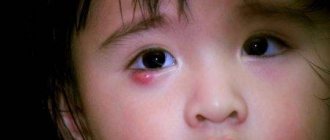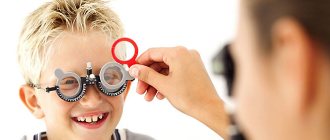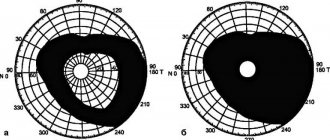Types of visual impairment
All visual impairments are divided into functional and organic. Functional ones include amblyopia (decreased vision that is not optically adjustable) and strabismus, which can be corrected. Organic disorders are pathologies of the structure of the eye and other parts of the visual system. They can lead to residual vision, low vision, and blindness.
According to the international classification of visual impairment, if the acuity of the better seeing eye after optical correction is less than 0.3, then this is low vision. If visual acuity is below 0.05, then the person is considered visually impaired. If visual acuity is below 0.02, then such people are officially recognized as blind. Children with residual vision, visually impaired and blind children are educated in specialized institutions.
Children with visual impairments. Perception of the surrounding world
In recent years, the number of children with disabilities in physical and mental development has increased. A special place in childhood pathology is occupied by visual impairments, which can lead to deviations in the formation of the visual system, low vision, residual vision or complete blindness. A significant part in the structure of eye pathology is occupied by refractive errors (myopia, farsightedness, astigmatism). Many children suffer from strabismus, amblyopia and other types of visual impairment.
Children with visual impairments, as a rule, attend special institutions (preschool educational institutions of a compensatory type, boarding schools for visually impaired and blind children), they are also in mass preschool educational institutions. In specialized kindergartens, teachers, speech pathologists and medical professionals work with children with visual impairments workers. Educational and correctional work is carried out by educators under the guidance of a typhlopedagogue and on the recommendation of an ophthalmologist in accordance with the characteristics of the general development and visual perception of children. All classes and all types of activities have a correctional direction. One of the main correctional areas is the development of visual perception.
This work should begin with determining a place in the classroom . If you have photophobia, the child should be seated so that there is no direct, irritating light entering the eyes. Children with low visual acuity take first place. With convergent strabismus, the child should find a place in the center. If the visual acuity of both eyes is different (i.e., with different visual capabilities), the child is seated with the better seeing eye closer to the center, to the teacher, who is at the board or stand on the right, always facing the children.
During classes, it is recommended to use special visual aids of certain sizes: larger for frontal demonstrations and strictly differentiated individual ones, corresponding to the indicators of the child’s basic visual functions (visual acuity, visual field) and visual pathology (myopia, amblyopia, etc.) When showing didactic material, visual aids, the teacher must take into account not only its size and color, but also the contrast of the background on which it is located. To perform visual work near, the plane of the working surface should be vertical or horizontal, depending on the type of strabismus (for divergent strabismus - horizontal, and for convergent strabismus - vertical) and on the nosological form of the eye pathology (for myopia, glaucoma - vertical, for farsightedness - horizontal ). That is why the teacher must constantly use a stand, flannelograph, easel, etc. for visual work of individual children.
In children with visual impairments, the pace of classes should be reduced compared to those with normal vision: such children need more time to initially and repeatedly examine the presented material.
An obligatory part of any lesson with children with visual impairments is physical education or rest minutes, during which it is necessary to carry out special exercises for the eyes (children often blink their eyelids without turning their heads, look right, left, down, up). It is recommended to conduct physical education sessions in a playful way and with musical accompaniment. When conducting them, the teacher must provide for the limitation of certain types of motor exercises: jumping is contraindicated for some children. tilts of the head and torso, etc.
Most children with visual impairments go to public schools: their visual capabilities allow this. Unfortunately, every third school graduate has decreased vision, which begins in preschool age. Therefore, the teacher needs to have scientific knowledge about hygiene, protection, and correction of visual deviations. He must:
1) competently use in educational work the information that is available in the child’s medical documents;
2) know the physiological and age-related features of its development;
3) be able to see individual signs (symptoms) of deviations in visual perception;
All this knowledge and skills will allow the teacher to carry out correctional pedagogical work at a fairly high professional level.
Familiarizing children with visual impairments with the world around them.
From the first days of life, a child begins to become acquainted with the world around him. Children in one form or another come into contact with objects and natural phenomena. In preschool children, the process of perceiving the world around them begins to purposefully form only with the participation of an adult. The development of an understanding of the world around us largely depends on how well the senses work. In children with visual impairments, the perception of an object is distorted, making it difficult to create a holistic image. Children with eye pathology have poor vision; therefore, it is important to teach them how to correctly visually identify specific signs and properties of objects, their size, shape, color and spatial location. All work to familiarize children with the world around them is based on the formation of analyzing observation, learning by means of analysis, generalization, comparison, classification, grouping, the formation of skills based on productive activities and the development of related monologue speech. The main methods and means are observation, examination, didactic games, exercises with natural objects, excursions, viewing filmstrips, presentations, examining various types of visual aids (pictures, dummies, toys) and listening to recordings.
Work plan to familiarize yourself with the outside world:
Acquaintance with the subject, natural environment with an object or phenomenon begins with observation (examination with the connection of stored analyzers). For example, how to form children's understanding of birds. From the beginning we observe the birds in the kindergarten area, paying attention to the behavior of the birds, their appearance, how they fly, move, and peck food. During correctional classes we use toys with characteristic features. After the examination, the children play with them, come up with fairy tales, stories, and riddles. Large pictures with bright images on a contrasting background are selected.
Mastering a generic concept - when we work on a specific topic, for example (plants or animals), we suggest that children should learn the identifying characteristics of plants and animals. This is necessary in order to group the objects being studied into generic categories on a specifically sensory basis. The most important thing is to accumulate as many ideas and generic concepts as possible.
Practical grouping. At this stage, it is necessary to show children the very fact of combining homogeneous objects into groups, the very process of grouping them, associated with the use of a generalized name, to give children a sample action for creating a group. Various didactic games provide great opportunities in this regard. For example: “Wonderful bag”, where various groups of similar objects are selected.
Classification. Teaching children classification as a cognitive action involves consistent development in them, the ability to perform operations, attribution, generalization and designation. The child analyzes a single object and identifies properties in it by which it can be classified into a group of similar objects. At this stage, you can offer children the game exercise “Arrange things on the shelf”, “Distribute pictures”, “What goes with what”. Here the child combines objects into one group, focusing on their belonging to one group or another.
Application of new knowledge. Here you can suggest the game “What has changed”. This game makes significant demands on the mental activity of children: it develops their ability to quickly compare objects with each other, establish similarities and differences between them, highlight the common feature of objects and make generalizations and relate the individual to the general. In this game, children practice classification not only as a practical activity, but also as a mental activity.
Practical activities. This stage is not particularly important when working with children with visual impairments; it is thanks to practical activities that the child develops an idea of the environment. In productive activities, the child represents a specific object in detail
Writing a descriptive story. One of the main tasks of a special institution for children with visual impairments is teaching connected speech, that is, the ability to clearly and consistently express their thoughts. Factors that facilitate the process of developing connected speech are clarity, which helps to name objects, their characteristic features, actions performed with them, as well as a plan of statements in the form of a diagram of specific elements of the statement, successively following each other. They are of particular importance for children with visual impairments, since impaired visual perception complicates the distribution of signs and properties of objects. In this regard, composing descriptive stories about objects causes certain difficulties for children.
Familiarizing preschoolers with the world around them is a means of educating their minds about knowledge about the world, based on experience and developing the right attitude towards it.
Of great importance for children with visual impairments in kindergarten is the formation of their ideas about sensory standards and learning how to examine an object. The sensory standards of color are 7 colors of the spectrum and their shades of lightness and saturation, the possibility of obtaining colors by mixing with others; as standards of form - geometric figures, values - the metric system of measures. Sensory standards in the field of color perception are the so-called chromatic (“color”) colors of the spectrum (red, orange, green, yellow, cyan, indigo, violet) and achromatic colors (white, gray, black). First, we form in children an idea of chromatic colors, white and black, and create conditions conducive to the assimilation of color names. We select the appropriate didactic games: “Extra color”, “Collect flowers”, “Match by color”, “Finish the pattern”, “Make a colored rug from squares”.
The main feature of an object, its sensory standard, is its shape. During the game, children develop the ability to visually analyze the shape of objects and correlate it with a sensory standard of shape: ball, cube, cone; circle, triangle, quadrangle, oval, later trapezoid (didactic games: “Pick up objects that look like a circle”, “Pick up objects that look like a ball”, etc.).
The visual perception of the shape of an object is influenced by the size of the object, the distance to the eyes, illumination, and the contrast between the brightness of the object and the background. Standards of magnitude are of a special nature. After all, magnitude is a relative property. Its exact determination is made using conditional measures. We offer children educational games: “Geometric mosaic”, “Which is more, what is less”, “Find your house”, “Make a pyramid”, “Guess the trail”.
We train children with visual impairments to classify objects according to a given sensory standard (for example, we teach them how to construct two or more geometric shapes. To do this, we use didactic games: “Fold 2 or 3 triangles into a Christmas tree,” “Fold 3 snowman circles”, etc.
When teaching children with visual impairments, we use standards of planar and three-dimensional geometric shapes. They display the most significant aspect of the shape of an object for perception - its outline. So, a circle is similar to the shapes of a ball and a plate. This gives grounds to use planar figures as shape standards.
Sensory standards of flat objects: cube, ball, cylinder, bar, parallelepiped, cone - the sensory stage of volumetric bodies. These ideas should be formed according to increasing complexity - from 1 to 3 sensory standards.
When comparing two objects, a conditional measure is used:
- children arrange objects in ascending and descending order by length, width, height, thickness;
- practice measuring length using different means: steps (children's and adults'), hand (children's and adults');
- children develop their powers of observation in determining the size of different objects;
- to compare the length (length, width, height) they use methods of positioning and measuring conventional measures (strips of paper, sticks);
- measure the distance in steps;
- learn to measure volumes of liquids and solids (using plastic mugs and glasses).
An item is judged to be large compared to another item, which in this case is small. To attract children's attention to the properties of an object, we invite them to place objects on top of each other; to compare by shape and size, place them close to each other, comparing colors. The ability to see an object depends on the child's field of vision, the size of the object and the distance from which it is viewed. Children are offered didactic games: “Look at the card through colored glass”, “Trace along the contour”, “Gather buttons on a string”, “Choose green, yellow, red”, “Name everything round”.
The main content of sensory perception in kindergarten is to familiarize children with the properties of objects, since it is the shape, size and color that are of decisive importance for the formation of preschool children’s visual ideas about the objects of reality, the social adaptation of children with visual impairments in the world around them.
Literature:
- Program of special (correctional) educational institutions of 4 types, ed. L. Plaksina. –M.: Publishing house “Exam”, 2005.
- A manual for kindergarten teachers. Publishing house Prosveshchenie, M., 1985.
- https://www.detskiysad.ru/ucheba/zapominanie08.html
- https://nsportal.ru/detskiy-sad/raznoe/2015/03/18/formirovanie-predstavleniy-o-mire-u-detey-s-narusheniyami-razvitiya
- https://openlesson.rf/ %D1 %81 %D1 %82 %D0 %B0 %D1 %82 %D1 %8C %D0 %B8/641143/
Features of development
The child’s psyche is affected by the time of formation of visual pathology, its severity, the presence of concomitant diseases, the effectiveness of treatment and the situation in the family. The earlier a visual defect appears, and the more pronounced it is, the more severely mental development is disrupted.
In children with visual impairments, the formation of personality is influenced by physiological and social factors: hypo- and overprotection, unfavorable social environment or family conditions, limited ability to access communication and receive information. It is difficult for such children to navigate in space, because of this they lead a sedentary lifestyle. This, in turn, causes muscle weakness (muscle hypotonia). To develop spatial orientation skills, it is necessary to constantly train the remaining analyzers (vibration perception, hearing, tactile and skin-kinesthetic sensitivity).
A developmental feature of infants with visual impairment is the absence of a grasping reflex. Such children do not reach for objects and begin to crawl, stand and walk late. Fearing head bruises, babies crawl feet first. They develop the skill of walking 2-3 years later than their peers. The lack of normal opportunity to explore the surrounding space sometimes causes delayed speech development.
Many children with visual impairment have normally developed speech, but the scope of cognitive activity, active communication, and imitation is narrowed. Blind people often use many words in their speech, the meaning of which they do not know. Therefore, when teaching such children, it is necessary to pay attention to the practical use of acquired skills and knowledge, and, if possible, use visual aids.
In children with visual impairments, hands are an important organ for perceiving the world around them . Therefore, it is necessary to develop finger, palm, and hand methods of perception. Blind older children should be able to read tactile relief-graphic images.
With low vision and blindness, children perceive fewer signs and properties of objects than their peers with normal vision. Reduced perception of color, integrity and completeness of the picture, low speed of perception make it difficult to understand the world around us as a whole. Because of this, children with visual impairments lag behind in development.
Visual concentration and differentiation in the visually impaired are reduced. They remember information slowly and become very tired. But if they remember something, then it remains in their memory for a long time. Visual memory is absent in the blind, and visual memory is weakened in the visually impaired. In children with visual impairments, visual control is absent or difficult. They have to remember information about landmarks in space, about where objects are located.
Blind and visually impaired children have reduced interests, needs, motivational sphere, and activity. At the same time, visual impairment does not affect their beliefs, worldview, temperament, or character.
Adaptation of behavior of children with vision pathologies
Absolutely all children go through an adaptation period when entering kindergarten. It can be observed from several days to a month. At this time, the child becomes whiny and often does not leave his parents. In the morning he may cry a lot and not want to go to kindergarten, even if he likes it there.
That is why it is necessary to accustom your child to attend kindergarten gradually. The visit starts from 1 to 2 hours. Gradually this time is increased. Not all children can immediately stay in the institution to sleep. This is very stressful for them. It is necessary to wait until the child enjoys visiting the kindergarten, only then leave him there to sleep.
When initially visiting the kindergarten, it is recommended to feed the child breakfast in the morning, since many children refuse to eat due to severe stress. Subsequently, you can not give your child breakfast in the morning if he himself wants to eat with other children.
The adaptation period also depends on the behavior of the parents. They should be restrained and not scold the child if he cries a lot. It is necessary to spend as much time with him as possible so that he understands that he is loved.
For children who have just begun to go through the adaptation period, no therapeutic manipulations are carried out. This is due to the fact that the child may get scared and start crying a lot, even to the point of hysteria, if any therapeutic actions begin without the participation of the parents. Therefore, it is recommended to agree to treatment only 6 months after starting kindergarten.
If the adaptation period is successful, the child gradually stops crying in the morning. He begins to enjoy interacting with other children. The most favorable age is 3.5-4 years. It is at this age that children develop communication skills and are interested in the people around them.
Education
The education system for visually impaired and blind children covers all age groups. There are preschool and school institutions. Preschool institutions do more than just educate children. They also carry out therapeutic and rehabilitation activities, develop visual functions, motor and cognitive spheres, and the child’s personality as a whole.
Schools for visually impaired and blind children are boarding schools that provide secondary education. Such schools have low class sizes - 10-12 people. The offices are equipped with special equipment. Specific teaching techniques and methods are used, such as large, high-contrast, clear visual aids. During training, hygienic requirements for visual work are strictly observed.
In high school, a lot of attention is paid to career guidance, so that the student chooses a profession taking into account the characteristics of his health. Classes are conducted on social rehabilitation, in which children are prepared for independent life in society. For this purpose, the school curriculum includes lessons in physical therapy, home economics, and spatial orientation. The main task of a special school is to correct visual impairments, develop a full-fledged personality, provide secondary education (the same level as in a regular school), conduct labor training and develop the child’s individual abilities.
Children with visual impairments need increased attention and care. Their development is slow compared to healthy peers. Proper home care for such a child and education in a specialized institution will help him prepare as much as possible for the upcoming independent life.
Differences between a specialized kindergarten and a standard one
Specialized kindergartens offer an individual education program for children with reduced vision function. Every day they receive classes to improve the quality of their hearing and vision.
Educators in such kindergartens must daily develop various outdoor games, with the help of which vision function will be stimulated, as well as impaired coordination in space will be corrected.
In specialized kindergartens there are toys that do not have sharp edges, since a child with reduced vision may not be able to see their parameters. Such toys should be large so that everyone can look at and choose them.
The kindergartens are equipped with specialized ophthalmological equipment, with which you can undergo the necessary health procedures every day, which parents cannot always afford at home. For example, they may contain a synoptophore, which can stimulate the extraocular muscles to correct strabismus.
Specialized kindergartens contain small groups. Groups are limited to 15 people, no more. In ordinary gardens there are from 30 people.
There are many doctors of various specialties in the kindergarten. This could be an ophthalmologist, speech therapist, neurologist, psychologist. They all examine the children and prescribe an individual program for the course of treatment.
Psychophysical characteristics of children with visual impairments
In the development of a blind preschooler, three general patterns can be distinguished:
- Such a child is somewhat behind in physical and mental development compared to a sighted peer, since his activity in relation to mastering the surrounding world is lower;
- The developmental periods of a blind child do not coincide with those of a sighted child. This occurs until the other senses develop mechanisms to compensate for the lack of normal vision;
- The development of a blind child is characterized by disproportionality - some aspects of the personality develop faster (speech, thinking), while others develop more slowly (mastery of space, movements).
An important characteristic of children with visual impairments is that due to insufficient development of motor coordination, blind preschoolers are clumsy and lack confidence. Thus, with congenital blindness, the delay in the formation of walking skills can be 2-3 years. The impulsiveness of preschoolers is at the same level as that of sighted children, but due to the lack of sufficient coordination, impulsiveness manifests itself more sharply and brightly.


